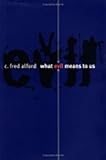What Evil Means to Us / C. Fred Alford.
Material type: TextPublisher: Ithaca, NY : Cornell University Press, [2018]Copyright date: ©1997Description: 1 online resource (200 p.)Content type:
TextPublisher: Ithaca, NY : Cornell University Press, [2018]Copyright date: ©1997Description: 1 online resource (200 p.)Content type: - 9781501720512
- 111/.84 23
- BJ1406 .A44 1997eb
- online - DeGruyter
| Item type | Current library | Call number | URL | Status | Notes | Barcode | |
|---|---|---|---|---|---|---|---|
 eBook
eBook
|
Biblioteca "Angelicum" Pont. Univ. S.Tommaso d'Aquino Nuvola online | online - DeGruyter (Browse shelf(Opens below)) | Online access | Not for loan (Accesso limitato) | Accesso per gli utenti autorizzati / Access for authorized users | (dgr)9781501720512 |
Frontmatter -- Contents -- Preface -- ONE. "I Felt Evil" -- TWO. Evil Is Pleasure in Hurting and Lack of Remorse -- THREE. The Ground of Evil Is Dread -- FOUR. Suffering Evil, Doing Evil -- FIVE. Identifying with Eichmann -- SIX. Splatter Movies or Shiva? A Culture of Vampires -- SEVEN "Evil Spelled Backward Is Live" -- EIGHT. Evil Is No-thing -- NINE. Scales of Evil -- Appendix 1. Asking about Evil -- Appendix 2. Informants and Questions -- Notes -- Works Cited -- Index
restricted access online access with authorization star
http://purl.org/coar/access_right/c_16ec
C. Fred Alford interviewed working people, prisoners, and college students in order to discover how people experience evil—in themselves, in others, and in the world. What people meant by evil, he found, was a profound, inchoate feeling of dread so overwhelming that they tried to inflict it on others to be rid of it themselves. A leather-jacketed emergency medical technician, for example, one of the many young people for whom vampires are oddly seductive icons of evil, said he would "give anything to be a vampire."Drawing on psychoanalytic theory, Alford argues that the primary experience of evil is not moral but existential. The problems of evil are complicated by the terror it evokes, a threat to the self so profound it tends to be isolated deep in the mind. Alford suggests an alternative to this bleak vision. The exercise of imagination—in particular, imagination that takes the form of a shared narrative—offers an active and practical alternative to the contemporary experience of evil. Our society suffers from a paucity of shared narratives and the creative imagination they inspire.
Mode of access: Internet via World Wide Web.
In English.
Description based on online resource; title from PDF title page (publisher's Web site, viewed 26. Apr 2024)


